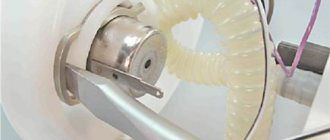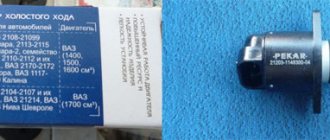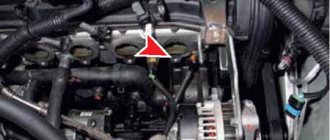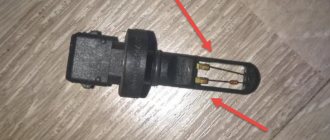The VAZ 2107 uses several temperature sensors. Some of them come standard with the vehicle, but car owners install some meters themselves.
The most important is the coolant temperature sensor, which is responsible for turning on the radiator fan. Not only the reliability of the vehicle, but also the life of the power unit depends on its serviceability.
PURPOSE OF TEMPERATURE SENSOR VAZ 2107
The sensor monitors the temperature of antifreeze in the main cooling radiator of the VAZ 2107 and transmits the signal to the dashboard. In its lower left corner there is a dial indicator for the antifreeze temperature.
Sensor showing coolant temperature VAZ 2107
If the temperature rises above 95 degrees, this means only one thing: the cooling system is not doing its job and the engine is close to overheating.
The temperature sensor of the VAZ 2107 transmits a signal to the dashboard
No signal when antifreeze overheats
On the dashboard at the bottom left there is a field where the temperature of the cooling fluid is indicated. When heated to 95 °C, it is concluded that the cooling system has failed and the engine may overheat.
There are cases when the signal is not transmitted:
- Burnt out cooling sensor. This usually occurs when there is a sudden voltage drop in the on-board network. The cause may be a short circuit in the electrical wiring.
- Blown fuse. It is detected visually, it will be blackened and slightly melted, which requires replacement.
- Broken wiring. To check, you can ring it or check with a multimeter for the presence of resistance.
The incorrect functioning of the DTOZH does not have the desired effect on the increasingly displaced carburetor.
ANTIFREEZE TEMPERATURE SENSOR DEVICE
Over the years, different types of temperature sensors were installed on VAZ 2107 cars. The earliest VAZ 2107 models had electromechanical sensors. Later they were replaced by electronic sensors. Let's take a closer look at the design of these devices.
ELECTROMECHANICAL TEMPERATURE SENSOR
Electromechanical sensors have a massive steel body with thick walls, ensuring more uniform heating of the device. The body contains a chamber with ceresite. This substance is mixed with copper powder, and it reacts well to changes in temperature. The ceresite chamber of the sensor is closed by a very sensitive membrane connected to the pusher. When hot antifreeze heats the sensor body, the ceresite in the chamber expands and begins to put pressure on the membrane. The membrane moves up a pusher, which closes the system of moving contacts. The signal thus obtained is transmitted to the dashboard, informing the driver that the engine is overheating.
The device of the electromechanical temperature sensor VAZ 2107
ELECTRONIC TEMPERATURE SENSOR
Electronic temperature sensors are installed only on new VAZ 2107. Instead of a membrane and a chamber with ceresite, the electronic sensor has a sensitive thermistor. As the temperature increases, the resistance of this device changes. These changes are recorded by a special circuit, which transmits a signal to the dashboard.
Electronic sensor device VAZ 2107
LOCATION OF ANTIFREEZE TEMPERATURE SENSOR ON VAZ 2107
The temperature sensor is screwed into the main cooling radiator of the VAZ 2107. This arrangement is quite natural: this is the only way the sensor can come into direct contact with boiling antifreeze. One nuance should be noted here: on early VAZ 2107 models, the temperature sensor also served as a plug closing the hole for draining antifreeze. In new VAZ 2107 cars, the drain hole is closed with a special plug, and the temperature sensor is screwed into its own, separate socket.
In old VAZ 2107 models, the temperature sensor also served as a plug
TEMPERATURE SENSOR FAULTS
There are two reasons why the sensor may not transmit a signal to the dashboard. Here they are:
- The fuse responsible for the temperature sensor has blown (the sensor itself may be working properly). To understand that the problem is in the fuse, the driver will have to look under the steering column, into the fuse block of the car. A burnt fuse will be immediately visible: it usually melts slightly and turns black;
Sometimes the sensor does not work due to a blown VAZ 2107 fuse - The temperature sensor itself has burned out. As a rule, this occurs due to a sharp voltage drop in the vehicle's on-board electrical network. The cause of such a jump may be a short circuit in the electrical wiring. The fact is that the insulation of wires on the VAZ 2107 has never been of high quality. Over time, it becomes unusable and begins to crack, which ultimately leads to a short circuit.
Why does the sensor fail?
There may be several reasons for the breakdown:
- Sensor insulation failure. If the wiring is poorly insulated, a short circuit occurs, which causes the device to burn out.
- The wires break near the sensor, which prevents the fan from turning on and the car overheats.
- The electrical contact located inside breaks or becomes cracked. In this case, accurate data transfer to the control panel is not possible.
Failure occurs more often in winter.
CHECKING THE TEMPERATURE SENSOR VAZ 2107
To carry out the test we will need the following tools:
- household multimeter;
- container with water;
- household boiler;
- thermometer;
- temperature sensor removed from the car.
TEST SEQUENCE
- The sensor is lowered into the prepared container so that its threaded part is completely under water.
- A thermometer and a boiler are lowered into the same container (you need to make sure that these tools do not come into contact with each other).
- The multimeter contacts are connected to the sensor contacts, and the multimeter itself is configured to measure resistance.
- The boiler is plugged in and the water starts heating.
- When the water reaches a temperature of 95 degrees, the sensor resistance shown by the multimeter should disappear. If this happens, the sensor is working. If at the above temperature the resistance on the multimeter does not disappear, the sensor is faulty and needs to be replaced.
VIDEO: CHECKING THE ANTIFREEZE SENSOR
Checking for serviceability
Before checking the operating capabilities, it is worth paying attention to the fuses. Often their burnout causes sensor failure.
You can independently check the sensor for correct operation using certain tools: a household multimeter, a boiler, a thermometer. A container of water will also come in handy.
- The entire threaded area of the sensor is placed in water.
- Together with the DTOZH, a thermometer is lowered into the container.
- The contacts of the multimeter and the sensor are connected, the resistance is measured.
- The boiler is immersed remotely from other devices and connected to the network, the liquid is heated.
- Indicative temperature – 95 °C. There should be no resistance with it. When the multimeter confirms this, it means that the spare part is functioning correctly. If resistance is observed, the device is broken.
Restoring the temperature sensor is not possible. There are no individual parts or materials available for sale that could be used to repair the device. The main reason is the cast housing design. The impossibility of disassembly does not provide access to the internals and, especially, to replace them.
REPLACING ANTI-FREEZE SENSOR ON A VAZ 2107
First of all, it should be said that the temperature sensors on the VAZ 2107 cannot be repaired. The reason is simple: this device does not contain parts and materials that the driver could purchase and replace himself. In addition, the body of the temperature sensor is not dismountable, so it is simply impossible to get to the insides of this device without breaking it. Here's what you need to replace it:
- new temperature sensor VAZ 2107;
- 30mm socket with a long wrench (or a regular spark plug wrench);
- container for draining coolant.
SEQUENCE OF OPERATIONS
- The car is placed on a viewing hole or on an overpass. Place a container under the drain hole, unscrew the plug, and drain the antifreeze.
A small basin is ideal for draining antifreeze from a VAZ 2107 - The contact wires are removed from the sensor. They must be carefully pulled towards you.
The red arrow shows the contact cap of the VAZ 2107 sensor - The sensor is unscrewed with a socket by 30 (remember that under the sensor there is a very thin o-ring that can be easily lost).
- A new one is screwed in place of the unscrewed sensor (and when screwing in a new sensor, you should not use too much force, especially if the driver of the socket head is very long: the thread in the sensor socket is easily torn off).
- The cap with the contact wires is put back on the sensor, and new antifreeze is poured into the expansion tank.
Replacing a spare part
The antifreeze temperature sensor on a VAZ 2107 is important for a carburetor engine, because if it malfunctions, incorrect data will be transmitted to the injector.
Before you start removing the old temperature sensor from the engine of the VAZ 2107, it must cool completely. Otherwise, liquid may cause burns when the hole is opened.
Independent replacement of the coolant meter on a VAZ is carried out in the following steps:
- De-energizing the on-board network to prevent short circuits in case of moisture on the wires. This can happen if their insulation is poor, but in any case, disconnecting from the network is recommended.
- Draining the antifreeze in the cylinders. To do this, you need to prepare the container in advance.
- Shifting the protective cap and disconnecting the contact wires. To remove, you need to pull them down and slightly towards you.
- Unscrewing the sensor using a 21-mm socket or wrench. When unscrewing, you need to be careful about the safety of the thin O-ring.
Before screwing in a new device, you should clean the connection points. Usually dirt and dust accumulate there, which also negatively affect work. In this case, you can use a rag that will not leave lint. The hole must be treated with a degreaser.
Installing a new meter following the reverse sequence of the listed points:
- Twisting the sensor. In this case, you should not make serious efforts to eliminate the risk of thread failure.
- Connecting wires.
- Closing the protective cap.
- Filling cylinder blocks with coolant. It is better to use new fluid, even if it has recently been replaced.
- Network connection.
- Start the engine.
- Checking the DTOZH.
Do not use thread sealant. Professional motorists and car mechanics do not drain the fluid before replacing it, deftly closing the hole with their hand. The removed device can be checked for serviceability.
IMPORTANT NUANCES
There are several important points that cannot be left out. Here they are:
- The above sequence of replacing the sensor with completely draining the antifreeze is not always used. Experienced car enthusiasts do it simpler: they unscrew the faulty sensor, then clamp the drain hole with their finger. This action requires a fair amount of skill. But even if you do everything very quickly, some of the antifreeze will inevitably spill out and you will still have to top it up;
Sometimes car enthusiasts do not drain the antifreeze from the VAZ 2107 when replacing the sensor - When going to the store to buy a new temperature sensor, you should remember: you can now find both electromechanical and electronic temperature sensors on sale. It is better to choose electronic ones, despite the fact that they are more expensive than electromechanical ones (a good electronic sensor costs 500 rubles, and an electromechanical one - 300). The logic of choice is simple: the fewer moving parts there are in the sensor, the longer it will last.
So, replacing a temperature sensor is not a very difficult task. Even a novice car enthusiast can handle it if he has held a wrench in his hands at least once in his life. By precisely following the steps outlined in this instruction, the car owner can save about 700 rubles. This is how much it costs to replace a temperature sensor at a car service center.
Temperature sensor VAZ 2107
The VAZ 2107 uses several temperature sensors. Some of them come standard with the vehicle, but car owners install some meters themselves.
The most important is the coolant temperature sensor, which is responsible for turning on the radiator fan. Not only the reliability of the vehicle, but also the life of the power unit depends on its serviceability.
Instrument location
The coolant temperature sensor (CTS) is embedded in the cooling radiator. It is this position, in which there is direct contact with the heating antifreeze, that ensures high sensitivity of the part.
In outdated models, the meter acted as a plug to close the tank. In the new ones, the drain passage is sealed with a separate plug, and the temperature sensor has its own hole.
Temperature sensors used
A coolant temperature sensor is used to inform the driver about the thermal state of the engine. It sends a signal directly to the instrument panel. If the temperature is close to critical, the driver has the opportunity to find out about it in time and take preventive measures.
The fan switch sensor is used to maintain the normal thermal conditions of the power plant. It ensures that the motor temperature is within a narrow range. Failure of the meter can result in engine overheating and antifreeze boiling.
The fuel temperature sensor is not present on all VAZ 2107 cars. Cars with a carburetor do not need this meter. On the VAZ 2107, the injector fuel temperature sensor appeared in 1995. Outside air and interior temperature sensors are not included in the basic configuration of the VAZ 2107. Therefore, car owners independently upgrade their cars by supplementing them with the listed meters.
For injection system
Forced fuel supply in the "seven" for the Russian market began to be used in 2006. In these car models, the fan operation and other functions are performed by the ECU. On the VAZ 2107 injector, the signal about the antifreeze temperature comes from the coolant temperature sensor, which is located on the right side of the engine cylinder block.
The data is processed by the ECU, which outputs a signal to the control relay to turn on the cooling - circuit diagram. The fan switching sensor is not needed on VAZ 2107 injection systems; it is replaced by a thermistor sensor, and control functions are assigned to the controller.
In any “seven”, to protect the fan from short circuit, there is a fuse F7 located in the mounting block.
Operation of the coolant temperature sensor for the injection system
Usually, turning on the fan on a VAZ 2107 is accompanied by a noise that the driver hears while sitting behind the wheel. A prolonged absence of sound from the device when driving around the city in the summer may indicate a malfunction in the cooling system, which can lead to antifreeze boiling and damage to engine components. The driver must react quickly to such defects so as not to spoil the “heart” of his car.
One of the possible malfunctions in the engine cooling cycle may be a breakdown of the coolant temperature sensor. In addition to the cooling system, it is responsible for the correct supply of the air-fuel mixture to the engine and its inclusion in idle mode.
The sensor that affects the operation of the VAZ 2107 injector fan consists of a semiconductor thermistor with two terminals, soldered into a housing with a thread that is screwed into the wall of the cylinder block. A constant voltage of 5 V is supplied to the device. As the temperature of the antifreeze increases, the resistance of the thermistor decreases and vice versa. At the input to the computer, passing through a resistor, the voltage drops as the coolant temperature increases to a certain level, after which the controller gives a signal to turn on the cooling.
How to check and install a new one
Checking the sensor responsible for turning on the fan does not require much effort. The following signs may serve as grounds for verification:
- The “Check Engine” light on the instrument panel is on.
- The fan operates continuously or is turned off.
- Low idle torque.
- Coolant overheating.
The cause of the malfunction may be outdated wiring. To find out for sure, you need to check it, and then move on to the sensor.
- The negative cable of the battery is disconnected.
- On a cold engine, the antifreeze drains to a level below the temperature sensor socket.
- The protective layer is shifted and the wiring from the temperature sensor is disconnected.
- Use a key to unscrew the sensor from its socket.
Next, check using a multimeter and boiled water. The multimeter is connected to the outputs of the temperature sensor and set to resistance measurement mode. The threaded side is placed in boiling water. If the resistance tends to zero, then the sensor is working. Otherwise, if increased resistance readings appear, the sensor requires replacement.
To replace it, it is better to purchase the same model that was installed when purchasing the car. Installation of a new sensor occurs similarly in the opposite direction.
Location of temperature sensors on the VAZ 2107
The coolant temperature sensor is located directly on the engine block head. It is located behind the fourth cylinder. In order to find where it is located, you need to look at the power unit on the left side.
You can detect the coolant temperature sensor by checking the wire going to it. The cable comes from the instrument panel and connects directly to the meter.
The coolant temperature sensor that turns on the fan is embedded directly into the cooling system line. It is placed in such a way as to provide the best sensitivity to changes in the thermal state of the engine.
The fuel temperature sensor is located inside the gas tank. It is attached directly to the fuel level meter. To warn the driver about a sensor malfunction, there is a special warning light on the instrument panel.
There is no original interior temperature sensor for the VAZ 2107. For installation, car owners usually buy a meter from a VAZ 2110. It is installed near the interior lamp.
The outside air temperature sensor is also not standard on the VAZ 2107. Therefore, owners install digital thermometers. The sensor is usually located under the front bumper. The display can be built into the instrument panel or located in a separate place, mounted, for example, on the windshield or dashboard.
For carburetor systems
There are still many VAZ 2107 cars in use on the roads with a carburetor supply of the fuel mixture. As in the injector, engine cooling occurs thanks to the radiator and fan, only the process is regulated by a fan sensor.
Location and principle of operation
On older cars, additional cooling begins when the antifreeze reaches a certain temperature, usually 92 °C (there are differences for individual sensors). Carburetor systems are equipped with 2 coolant sensors - one to regulate fan operation, and the second sends readings to the driver’s instrument panel.
The sensor that turns on the fan is located on the bottom of the radiator panel, on the right side. To see it, you need to lift the hood and on the back you can see a “nut” with wiring. Usually these are modifications of the TM-108.
The principle of operation is to change the volume of the working fluid of the sensor when the temperature of its working fluid fluctuates. Inside the thick-walled steel housing is a working mixture covered with a flexible plate attached to a pusher that connects the contacts when the sensor is triggered.
In the steel case, the sensor heats up evenly, the working fluid expands and the contacts are connected, the fan is activated.
There are several modifications of the devices - TM108; TM108-10; 661.3710. The first is designed for operating temperatures: 92–99 °C (contact activation and disconnection). The second is designed for colder operating conditions: 87–92 °C. These sensors operate in a circuit with an additional relay and can withstand a current of 1 A. If a relay contact is not provided and the fan is connected directly to the sensor, then the latest 16 A model is used.
Cost of sensors
VAZ 2107 temperature sensors have an attractive price. Their low price is due to the simplicity of the design, inexpensive production process and the absence of the need to use expensive materials. Therefore, if any meter does not work, you need to check it and, if necessary, replace it. The table below shows approximate prices for sensors.
Table - Cost of temperature sensors VAZ 2107
| Sensor | Cost, ruble |
| Fan switch sensor | 300-450 |
| DTOZH | 370-500 |
| Outdoor temperature sensor | 340-700 |
| DTS | 240-500 |
| Fuel temperature sensor | 450-800 |
Do-it-yourself replacement of the fan switch sensor
To replace the temperature sensor responsible for turning on the radiator fan on a VAZ 2107, it is recommended to follow the instructions given below.
- Remove the terminal from the battery.
- Drain the coolant from the radiator.
- Remove the terminals.
- Using a 30mm key, unscrew the meter.
- Check the condition of the copper O-ring and screw in the new sensor.
- Reassemble everything in reverse order.
Replacing the coolant temperature sensor
A huge hello to everyone again. This article probably wouldn’t have existed if one of the female representatives hadn’t written to me: “how can I replace the ID because it doesn’t show correctly for me and where is it located?”
I had no right to refuse, and I had the same problem myself.
So let's go. First, we buy the sensor itself.
here he is
view without box
marking
Here I would like to draw your attention, we only need TM 106, since other modifications are available for the Volga and Gazelle, however, all this is written on the sensor boxes, although not on all of them.
Now friends, what we need to replace the engine is just a 21 spark plug wrench and a screwdriver or something similar.
all tools for replacing the sensor.
Now let's talk about the location of the dozh - everything is simple, it is located in the block next to the candles.
close-up
Well, the actual replacement, for which the ABC books say drain it, but we won’t do that, we’ll simply turn the new sensor over to the old one, losing a maximum of 10 grams of antifreeze, but the screwdriver couldn’t stand the pain.
The Chinese don't know how to do this.
Well, after warming up the engine we get excellent results.
everything works, everything shows as it should.
So, I hope my visual aid will be useful to someone, see you all again and good luck on the roads)))











